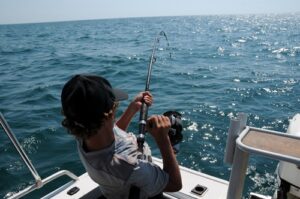Fishing Boat Maintenance. Tips For Looking After Your Boat.

A boat can give you years and years of fishing fun. However, to keep the boat looking nice and keeping it running well, there are some maintenance to do and upkeep.
Fishing boat maintenance could be broken down into two stages, or time frames when it should be done. One time that should be performed is after each boating trip. The other is for regular set maintenance periods, like a yearly boat engine service.
In this article we will cover how to maintain your fishing boat. With information on: fishing boat washing tips, how to store your boat, caring for the boat on the water, maintaining your boat for long term, caring for your boat trailer and a boat maintenance checklist.
But first let’s start with step by step on how to wash a boat.

How to wash a fishing boat.
No. 1 Hosing the boat down.
First remove seat cushions and any items that may get wet in the bow cockpit or storage hatches.
Remove or cover, or avoid wetting any electrical areas like batteries, wiring, lighting or fish finders.
Remove any rubbish, like plastic wrappers, loose sinkers or fishing line so it doesn’t plug up the drain hole/s.
Unscrew the drain hole plug/s or bung plug. (Sometimes I will keep the drain hole plug in, until I soap it up. This helps soaks the floor and helps remove some stubborn grime and blood. Then I remove the plug when rinsing the boat out.)
Some fisherman will remove the canopies and Bimini tops before washing the boat. But in most cases they can be left on and washed or wiped down together when washing the boat.
Give the boat a hose down inside the cockpit and hull, wetting inside and out.
No. 2 Scrubbing the boat.
Fill a bucket with warm / hot water and some marine wash detergent.
Use a soft bristle brush, sponge or a microfiber cloth and scrub away. (Don’t use a hard brush on canopies or Bimini tops as it can scratch them.)
If you have been fishing in the saltwater, or for those nasty messy deck areas with fish blood, a hard scrub and some extra elbow grease and attention might be needed.
Be careful scrubbing around decals, graphics, stickers and pinstripes.
Give GPS units and fish finders / a light wipe over to get rid of any salt mist or grime You can give them a light mist, but be careful spraying the wires or with too much water.
Anchor wells, rust spots and hard to get at corners in the boat, can need extra cleaning.
No. 3 Rinsing the soap off.
Hose the inside area out first, washing off the detergent. Hose of any areas off on the hull and outside.
No. 4 Waxing or polishing the boat.
For the fisherman who is pedantic about keeping the boat spotless, this is the step where they really shine. (Pardon the pun.)
A microfiber cloth and a marine shine polish or wax can really spruce the metal surfaces up. This makes your stainless steel areas of the boat look spic and span.
You can use a UV protectant spray for vinyl like this one below from Amazon. (Affiliate link click on 303 Marine UV Protectant Spray for more information and latest price.)
No. 5 Drying the boat.
Ideally let the boat dry and air it out under shade, not in bright direct sunlight.
You can use a drying chamois cloth or just let it air dry.
Make sure the boat is dry before putting boat covers, seat cushions and canopies back on.

Boat washing tips.
A small step ladder is handy for getting in and out of the boat. Also for bigger boats it helps reach the hard to reach up high places when on a trailer.
Bribe the children with candy to help wash the boat or pay them. (I know that junk food isn’t good for the kids, but it does motivate them.)
A long handled brush makes it easier to reach.
Be careful with hard stiff brushes for the windows and canopies as you don’t want to scratch the windows or damage the fabric.
For boats with removable floors, you could remove the decking panels, marine carpet, rubber matting or flooring sections. This can be stood up or hung over the side of the boat and hosed down and washed at the same time.
Wind up the jockey wheel / jack or place cinder blocks under the front of the trailer to angle it up slightly. (Make sure it is not too over balanced and tips up on the outboard motor.) This will make the water drain out easier.
Make sure no water is going to get in the outboard fuel tanks or connections. My farther used to put a plastic bag over the fuel hose.
Some fisherman just leave the rods in the boat and items like landing nets, life jackets, rod holders, oars, anchors, buckets in the hull. These are wet secondary from the spray and detergent foam and washed indirectly.
You can also place a tub in the middle of the boat and for the scuba divers and spear fisherman, place the wetsuit and fins for a rough wash. (Click on, How to wash a wetsuit for more information.)
A lot of drive in car washes were you clean it yourself, are a great place to wash the boat, as they have all the cleaning gear.
Schedule the boat wash on warmers days so it dries quicker. Also washing it in the morning, will help it dry better, as there is more daylight and warmth. As opposed to washing it late in the afternoon and less time for the boat to air dry.
Can you use car wash to wash a boat? Yes you can, ideally you want a marine boat wash that can do both a gelcoat and a metal surface. However, a car wash solution is fine in a pinch.
Can you use a high pressure washer on the boat? Yes, however, be careful around stickers, decals and the canopies, etc. If you have different pressure settings try it on the low pressure first. Avoid holding the pressure nozzle to close to the
A pressure washer is great for neglected hulls that might have any barnacles or hard to remove grime. But be careful on old hulls as paint, gel coats that have sections that are chipped or cracked, the pressure can flake these areas off more and damage the hull.
Caring for your boat on the water.
Be careful when bleeding the fish, don’t do it on the deck or flooring. Use a bucket, or do it over board or on a bait cutting board that can drain away.
Have a spare sponge and bucket. This not only great for cleaning the fish mess up, but also if you get a little bit of water on the floor deck you can soak it up.
Bailing buckets can be used for collecting some water over board than using it to pour on any mess to wash it down.
Have a cutting board, rather than trying to slice bait up on the chiller box lid or boat seats.
Use a rubbish bag or pail for packaging. You don’t want the crisp packet flying into water a rubbishing the waterways or ocean, it is not only awful to look at, but can be destructive to wildlife and fish.
Use bumpers and fenders for bigger fishing boats when docked, or tied up at the pier.
How to protect your fishing boat.
The sun’s UV rays are harsh on boat upholstery, Bimini tops, boat canopies and paintwork. So it is important to keep them out of the direct sunlight.
With storing the boat, we have three main options for covering it up or keeping it out of the elements.
- We can cover a smaller boat up with a tarp when outside. (Or a couple of tarps on a bigger boat.)
- Use a properly designed boat cover. Remember to protect the boat engine.
- Store it under a lean to or in the shed / garage.
If you are using a tarp or boat cover outside in the elements, make sure that it doesn’t collect rain water and sag in the middle. You might have to prop up a stick in the center or place a cross beam so the tarp or cover doesn’t sag and the angle runs the rain water off.
Avoid storing boats in the sun, especially fiberglass boats.
How to store your fishing boat and maintain it.
For storing the boat, check it is cleaned properly as you don’t want mice to be attracted to the bait smell or any leftover food crumbs or rubbish.
Pack the PFD (Personal Flotation Devices.) and extra spare jackets are stored dry in a waterproof container. So no mice can call home and nest in them.
Mice and rodents can chew your spare clothing. I have had mice chew my kayak wetsuit and fishing waders stored away in an open plastic tub.
Insects, ants and nasty spiders can also be a concern in warmer climates for calling your boat home. It is best checked periodically so everything is clean and creepy crawly free.
Disconnect the battery terminals or isolate connections and inspect so there is no corrosion around terminals. Charge the batteries to maintain them.
Flush your boat motor if you have been in the saltwater or are not planning to take a fishing trip for a while.
Take the cowling off to make sure nothing is eroding or there isn’t any leaks in the motor.
Check fuel hoses for cracks.
If you have hatches, open them up and let them air.
Check the propeller for cracks, dints and chips. A banged up propeller won’t be as efficient or powerful driving the boat through the water
For fishing boats with a bilge pump, you can maintain the boats bilge pump by flushing it with fresh water. Place the bungs in and fill the hull with freshwater. Use enough to cover the suction points.
For smaller fishing boats, check the oarlocks, if they have a rubber parts that need replacing.
If you do a lot of night fishing or on the water at dawn or dusk, check your safety boat lights and lighting.
If you are storing your boat in long term storage facilities, you have to be even more careful about cleaning the boat beforehand and preparing it for storage. As you might not see it for several months.
Have a spare bung drain plug or two for your boat, in case you misplace it.
Caring for your boat trailer.
Inspect your trailer lights indicators and brake lights are working. Make sure they are submersible and waterproof, like these ones below from Amazon.
Check these a few days before the fishing trip. As there is nothing worse than going to leave for the fishing trip and you are all excited to get going, than your wife notices that your boat trailer lights are not working. (It has happened to me a few times and all I can think about is lost fishing time.) You than spend the next hour trying to get them working.
I have a friend which his mudguard was angled the wrong way, during a trip the stones were flicked up into the boat hull when traveling. It really chipped and marked his boat. He welded on the trailer mudguards, so now loose stones fling up from the trailer is not a concern.
When you stop to get some gas or toilet breaks, have a walk around the boat and trailer and makes sure everything is tied down well. Is the outboard motor still secure?
Trailer tires should be checked for pressure before you go for a fish. The tread should also be checked for wear.
The old saying you get what you pay for is generally true for tires. The cheaper trailer tires brands don’t seem to wear as long, but there are always exceptions and I have had well known good brands wear excessively (The wheel alignment was fine and the miles travelled wasn’t excessive.)
Look on the boating and fishing forums about some good brands that are hard wearing and you shouldn’t have to re-place too often depending on your miles travelled to those fishing hotspots.
Remember to check the trailer wheel bearings every so often, especially before long trips.

A checklist for the super fussy organized fisherman.
For those super pedantic fisho’s, you might even have a boat maintenance checklist on a yearly calendar.
It might have on the checklist: get the boat motor serviced, marine batteries checked, wheel bearings on the trailer checked or replaced, boat winched checked, trailer wiring checked, etc.
The super prepared fisherman might even go as far and cover fishing line being replaced yearly on the rods and the reels greased. Lures and hooks sharpened and new leaders and wire tracers made up, ready for the fishing season.
You might even have a checklist for you safety gear like make sure your emergency flares are up to date and not expired. Ensure your fishing licenses up to date. (Click on Californian fishing license cost and How much is a Texas fishing license? for more information.)
Check your fishing boat insurance policy is up to date. (While we are talking about boating insurance check your policy that it includes; storing your boat for theft, damage, fire etc., at your residence, but also if you take it camping and park it, not just insurance for on the water, etc. The fine print can be hard to decipher, so a good boat insurance broker can help.)
Conclusion.
As you can see, it doesn’t really take a lot of time to maintain the fishing boat. A few checks and some care and the boat can be kept running in good working order.
Remember to put the boat drain plug back in, before you put the boat in the water.
Good luck fishing.


